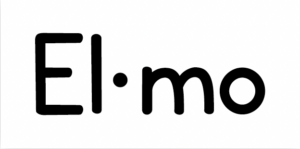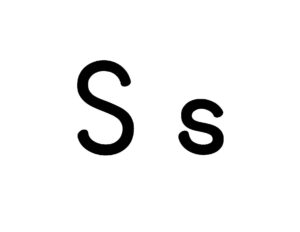Phonological awareness, Letter knowledge
Children will blend syllables into a word. Children also will identify the name and sound of the letter S.


Review:
Be Prepared: Prepare a name card for demonstration purposes, using a two-syllable name of a classroom pet or a character known to the children. Divide the name into spoken syllables with dots. The name “Elmo” is used in the activity as an example.
We are learning how to divide our names into syllables. Remember, parts of a word are called syllables.
Today we will play a robot game. I am going to pretend to be a robot! Listen carefully as I speak like a robot.
[Alter your voice so that it sounds like a robot. Speak in short, choppy sentences while separating multiple-syllable words into syllables.]
I am a robot. Can you help me? Can you tell me what I see?
 [Display the name card “Elmo.”]
[Display the name card “Elmo.”]
I see a name. The name is El-mo.
[Enunciate each syllable slowly in “robot talk.” Pause briefly between syllables.]
What name do I see? (Elmo)
[Say the following in your regular voice so that you no longer sound like a robot.]
Now each of you will have a turn to say the name I see. I will pretend to be a robot and ask each of you to help me. I will say a name in “robot talk” and then the person whose name I am saying can help by telling me what name I see!
[Hold up each child’s name card. One at a time, say the name in “robot talk,” and then ask the child to say the name by blending the syllables in the word.]
Let’s learn more about the letter S.
 [Display letter S card.
[Display letter S card.
If a child(ren) whose name begins with the letter S was identified on Day 2, invite the child(ren) to again pop up. Say the first name of the child(ren). Emphasize the sound of the letter S when you say the name.]
Maybe someone in our group has the letter s somewhere else in their name. The letter might be in the middle or at the end of their name. It will be a lowercase s and it will look like this.
[Point to the lowercase s on the letter card.]
Pop up if you have the letter s somewhere else in your name (not at beginning).
[If a child has the letter s somewhere else in his/her name, point to the name and to the letter s on the list of children’s first names so all children can see the name and the letter s.]
What is our word that begins with the letter S? (syllable)
The letter S says /s/, just like at the beginning of the word “syllable.” /s/, /s/, syllable. Let’s say that together: /s/, /s/, syllable.
I have two pictures of things that begin with the letter S.

[Hold up one picture card and invite children to identify the item/emotion in the picture. After children have an opportunity to guess or say the pictured item/emotion, point to and say the word written at the bottom of the card. Example: “This word says sock. The letter s is at the beginning of the word.” Repeat this procedure with a second picture card.]
Let’s think of some other words that begin with the letter S and write them on our chart. Remember, the letter S says /s/, /s/.
[Help children by suggesting other words that begin with s. Examples: sat, silly, sip, seven.
Invite one or more volunteer children to find the letter s in words on the chart. Children may point to the letter at the top of the chart and then find it in one of the words below.
Demonstrate and describe how to make the uppercase letter S on your chart paper.]
We use one line to make an uppercase S. The line swoops around like a snake.
[Give each child his/her letter journal.]
Now we are going to write the letter S in our letter journal. Please write the uppercase (big) letter S in your journal. Write as much of the letter as you can.
Today we listened to the syllables in our names as I said the name in “robot talk.” Then we put the syllables together to make someone’s name. When we talk like a robot we can hear the syllables in a word!
We also learned that the letter S says /s/, just like at the beginning of the word “syllable.” We made the uppercase (big) letter S in our letter journal. Let’s say together the sound the letter S makes (/s/).
Extra support
Enrichment
Provide *animal syllable cards used in Week 13, Day 2. Encourage children to say each animal name using “robot talk.”
*Printables provided
Play an outdoor robot game to help children learn more about syllables. Provide several small boxes with holes cut for eyes. Invite children to put a box on their head and pretend to be a robot as they talk in “robot talk.” Encourage children, as you use “robot talk,” to say the names of items with two or more syllables. Example: “Nuan, I see that you are building a spaceship. Tell us about your spaceship like a robot!”
Pattern knowledge
Children will make an ABAB pattern through movement.

None

Review:

We are learning about patterns. We know that a pattern is something that repeats itself. Today we are going to make a pattern by moving parts of our body.
We make a pattern with our feet when we walk. Please watch the pattern I make.
[Walk slowly while saying left foot, right foot, left foot, right foot, etc.]
We move in a pattern when we walk. Let’s all stand and try it together.
[Walk slowly as children follow your lead. Encourage children to say the pattern as they walk; “left foot, right foot, left foot, right foot.”]
Now let’s do another pattern by moving our feet. Let’s try a heel, toe, heel, toe pattern. Let me show you.
[Slowly demonstrate the pattern with one foot while saying “heel, toe, heel, toe, etc.”]
Let’s try it together.
[Encourage children to say the pattern as they put their heel and then their toe on the floor. Continue saying and doing the pattern slowly as children follow. Invite children to sit.]
Let’s try some patterns with our hands. Let’s first clap our hands together once and then tap our knees once. Try it with me. Clap, tap, clap, tap, clap, tap, etc.
[Say and do the pattern slowly as children follow your lead.]
What is another pattern we can do with our hands?
[Try children’s ideas. Examples: touching head, touching toes, touching head, touching toes; clapping in front, clapping in back, clapping in front, clapping in back.]
Today we made patterns by moving some parts of our bodies. What did we do?
Extra support
Enrichment
Provide shapes (pattern blocks) for children to make simple ABAB patterns.
School-age children may enjoy making up movement patterns for each other. Encourage them to try more challenging movement patterns, such as: jump, jump, clap, spin, jump, jump, clap, spin.
Motor development
Children will pay attention to body movements when running and jogging in place.

None

New:

We are learning how to pay attention to our bodies when we move in different ways. Today we will focus on how our body moves when we run.
Let’s run in place. Remember, we stay in our own space when we run in place. Listen (or watch) for the signals to start and stop running in place.
[Offer a “start” signal and encourage children to run in place for a short time. Give a signal to stop movement.]
That was great! We stayed in our personal space to run in place. Some of us moved our arms back and forth to help us run.
We move our legs fast when we run. Our elbows are bent and our arms swing back and forth. We can run faster when we swing our arms.
Let’s run in place again. This time, please focus on how our arms move. Start out with a slower run and then run faster in place. Notice how our arms move faster when we run faster.
[Offer a start signal and encourage children to run in place. Give a signal again to stop movement. Remind children to run a little faster after they start running.]
What did our arms do when we started running faster? (moved faster)
Now let’s practice running slower. We will run in place. A slower run is called jogging. Let’s try jogging in place.
[Offer a start signal and encourage children to jog in place for a short time. Give a signal to stop movement.]
We have practiced running and jogging. What is the difference between running and jogging? (move faster when we run)
Now I will say some ways to move our bodies by running or jogging. Try to move your body the way I suggest.
[Offer a series of requests involving movement combinations suggested below. Demonstrate each request.]
Today we practiced running and jogging. We paid attention to how our arms moved when we ran and jogged.
Extra support
Enrichment
For outside play, invite children to play a version of Red Light, Green Light. Add the variation of: green light run, or green light jog. Encourage children to think about their speed when running and jogging.
School-age children in your setting may enjoy demonstrating the movement requests.
Exploring Where We Live
Social Studies
Skill and Goal
Knowledge of physical environments
Children will broaden their understanding of a neighborhood.
Materials
Needed
Key
Concepts
Review:
Also
Promotes
We are learning about neighborhoods. Remember, our homes are located in neighborhoods. Our child development center is located in a neighborhood.
Let’s think of some of the places that are near our child development center. We will call this our center neighborhood.
Today we are going to work together in groups to make places that are in our center neighborhood. We will use boxes to make our places. Remember, when we work together we take turns and talk about what we want to do. Each person in the group will help decide how the place you make will look.
[Organize children into small groups of 3–4.]
Let’s look at our pictures (or chart) of places in our center neighborhood.
[Display the pictures (or chart) and help each small group decide which place it will make. Provide art materials, such as paper, markers, glue, tape, child-size scissors, crayons, and any other supplies that children might be able to use.
Help groups decorate their places as appropriate. Children will also have an opportunity to work on their neighborhood places tomorrow.]
Today we worked together to make places in our center neighborhood. Some groups were able to finish, and some groups are still working. We will share our places when they are all finished.
[Children will describe their box places in Week 15. Display them in your room if space is available.]
Scaffolding Tips
Extra support
Enrichment
Center Activity
Provide materials for children to continue working on their box places.
Family Child Care
Encourage older children in your setting to make a Family Child Care neighborhood book. Ask children to name their favorite place in their neighborhood and then draw a picture of it. Encourage children to write on the bottom of their page what they like most about their favorite place. Combine the pages into a book. Encourage children to share their page of the book with family members at pickup time.